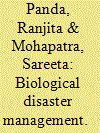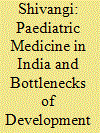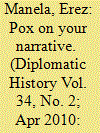|
|
|
Sort Order |
|
|
|
Items / Page
|
|
|
|
|
|
|
| Srl | Item |
| 1 |
ID:
102725


|
|
|
| 2 |
ID:
126257


|
|
|
|
|
| Publication |
2012.
|
| Summary/Abstract |
Biosecurity measures are traditionally applied to laboratories, but they may also be usefully applied in highly specialized clinical settings, such as the isolation facilities for the management of patients with highly infectious diseases (eg, viral hemorrhagic fevers, SARS, smallpox, potentially severe pandemic flu, and MDR- and XDR-tuberculosis). In 2009 the European Network for Highly Infectious Diseases conducted a survey in 48 isolation facilities in 16 European countries to determine biosecurity measures for access control to the facility. Security personnel are present in 39 facilities (81%). In 35 facilities (73%), entrance to the isolation area is restricted; control methods include electronic keys, a PIN system, closed-circuit TV, and guards at the doors. In 25 facilities (52%), identification and registration of all staff entering and exiting the isolation area are required. Access control is used in most surveyed centers, but specific lacks exist in some facilities. Further data are needed to assess other biosecurity aspects, such as the security measures during the transportation of potentially contaminated materials and measures to address the risk of an "insider attack."
|
|
|
|
|
|
|
|
|
|
|
|
|
|
|
|
| 3 |
ID:
170174


|
|
|
|
|
| Summary/Abstract |
This article argues that the poor state of paediatric medicine in India still restrains and often prevents the healthy development of far too many young Indians. Infants as junior-most citizens deserve diligent care, as they have legal entitlements to specialised medical services, ensuring their survival and healthy growth, ultimately for the benefit of the entire nation. The article first traces the somewhat stunted colonial institutional development of paediatric medicine in India. It then proceeds to perform a critical analysis of the continuing harm of negligence concerning the health and upbringing of India’s vulnerable infants, challenging the state to become more committed to integrated child development.
|
|
|
|
|
|
|
|
|
|
|
|
|
|
|
|
| 4 |
ID:
095527


|
|
|
|
|
| Publication |
2010.
|
| Summary/Abstract |
When Dr. Viktor M. Zhdanov, Deputy Minister of Health of the Soviet Union, arrived in Minneapolis, Minnesota, in May 1958 to attend the annual meeting of the World Health Assembly (WHA), the governing body of the World Health Organization (WHO), the visit was not routine.1 Reflecting Soviet premier Nikita Khrushchev's new policy of "peaceful coexistence" with the West, it marked the first time that a Soviet delegation had been sent to that forum since the establishment of the WHO ten years earlier.2 And Zhdanov made his mark, calling on the organization to launch a global campaign to eradicate smallpox, one of humankind's oldest and deadliest diseases. Mindful of the meeting's venue, he began his call with a quote from a letter that U.S. president Thomas Jefferson had written to Edward Jenner, discoverer of the smallpox vaccine, more than a century and a half earlier. The discovery, Jefferson had written the English physician in 1806, would ensure that "future nations will know by history only that the loathsome small-pox has existed.
|
|
|
|
|
|
|
|
|
|
|
|
|
|
|
|
| 5 |
ID:
159753


|
|
|
|
|
| Summary/Abstract |
Using reports about local resistance of the smallpox vaccination between 1800 and 1805 in colonial India, this brief article analyses how the diversity in both the level and type of resistance, depicted in earlier primary sources, has been distorted by later accounts into a single category of ‘South Asian smallpox vaccination resistance’. Careful analysis of the historical primary documents demonstrates, however, that such resistance stemmed from a variety of reasons, including sanitary concerns, political discontent and practical difficulties in arriving at vaccination centres. The article therefore suggests the need for more careful handling of earlier primary sources in order to not lose evidence of early diversities in reactions to colonial interventions.
|
|
|
|
|
|
|
|
|
|
|
|
|
|
|
|
| 6 |
ID:
126181


|
|
|
|
|
| Publication |
2012.
|
| Summary/Abstract |
The U.S. government has taken significant steps toward developing and acquiring vaccines, drugs, and other medical countermeasures (MCMs) to protect and treat the population after a biological attack. In contrast to 2001, there is now a procedure for the Department of Health and Human Services (HHS) to develop, license, and stockpile MCMs for civilian use. Another major accomplishment is smallpox preparedness: There is now an adequate supply of vaccine for every person in the U.S., and there is an alternative vaccine meant for immunocompromised people and those with close contact with them. In spite of these and other accomplishments, the U.S. government MCM effort has been criticized by federal advisory committees, National Academy of Sciences reports, a congressional commission, and outside analysts who state that the efforts lack central leadership and accountability and that the pace of progress has been slow. A clear operational strategy for using MCMs, which would guide their development and acquisition, is also lacking. In this article, we review key areas of progress made since 2001 to develop and acquire MCMs, and we summarize what we judge to be the most critical and often mentioned areas where improvements are needed.
|
|
|
|
|
|
|
|
|
|
|
|
|
|
|
|
|
|
|
|
|